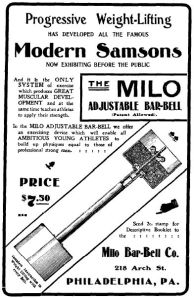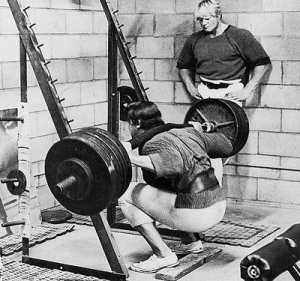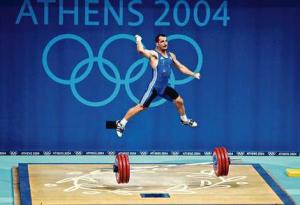The barbell is and always will be the most effective training tool for total fitness. Basic barbell training is used by the biggest, strongest, fastest, most powerful, and most conditioned athletes on the planet. It works for them and it will work for you. Barbells have been used in Europe since 1880 and in America since the turn of the 20th century when Milo Barbell Company first started manufacturing them. The barbell is the best overall tool for achieving impressive levels of hypertrophy, strength, speed, power, and conditioning. The barbell is also very useful for producing clean movement patterns during high velocity sports movement.
Dumbbells, elastic bands, JC bands, kettlebells, sleds, chains, weighted vests, cable columns, slideboards, Valslides, stability balls, Bosu balls, TRX systems, blast straps, towing chords, sandbags, clubbells, medicine balls, battle ropes, kegs, logs, tires, unique bars, other odd objects, and machines are excellent training tools that all take a back seat to the barbell in terms of total body fitness production.
Perform explosive movements with a barbell and you’ll build speed and power. Focus on heavy eccentrics and you’ll improve your agility. Load the bar up heavy for low reps and you’ll build maximum strength. Perform medium to high reps and you’ll experience appreciable muscular hypertrophy. Use it for ultra-high reps to increase muscular endurance. Perform complexes consisting of several exercises done back to back without rest and you’ll build work capacity and stamina. Want to improve your balance and multiplanar single leg stability? Focus on unilateral lower body barbell movements. Want total body functional conditioning with transfer through the entire core region? Perform standing movements that place the barbell on your back or in your hands. Use a barbell to perform loaded eccentric quasi-isometrics (EQI’s) and you’ll rapidly increase your flexibility. Perhaps the most overlooked component of all…the barbell is the ultimate tool for aiding in the development and reinforcement of proper motor patterns during high velocity sporting movements as the athlete gets stronger and faster. Strength improves posture, form, stiffness, and the ability to hold technique and preserve efficient kinetic transfer under quicker and higher-energy athletic action.
Let’s take a closer look!
Hypertrophy
Any experienced lifter will have a hard time arguing that the squat, deadlift, bench press, military press, and bent over row are not the top five exercises for laying down a thick foundation of muscle mass. Many gurus refer to these five lifts as “The Big Five.”
The following is a pretty comprehensive list of exercises broken down into specific regions that can be used to gain muscular size.
Quad/Glute
Half Squat, Parallel Squat, Full Squat, Sumo Squat, Front Squat, Zercher Squat, Box Squat, Barbell Hack Squat, Overhead Squat, Kneeling Squat, Jefferson Lift, Static Lunge, Walking Lunge, Reverse Lunge, Side Lunge, Forward Lunge, Front Lunge, Zercher Lunge, Barbell Pistol, Barbell Step Up, Bulgarian Squat
Ham/Glute
Conventional Deadlift, Sumo Deadlift, Romanian Deadlift, Straight Leg Deadlift, Snatch Grip Deadlift, Deficit Deadlift, Rack Pull, Zercher Romanian Deadlift, Good Morning, Sumo Good Morning, Single Leg Romanian Deadlift, Single Leg Good Morning, Original Good Morning, Barbell Glute Bridge, Hip Thrust, Barbell Single Leg Hip Thrust, Barbell Back Extension
Chest/Tri
Bench Press, Incline Press, Decline Press, Close Grip Bench Press, Board Press, Close Grip Board Press, Floor Press, Close Grip Floor Press, Reverse Grip Bench Press, Bridge Press, Guillotine Press, JM Press, Skull Crusher, Overhead Extension
Back/Bi
Deadlift, Rack Pull, Barbell Pullover, Bent Over Row, Underhand Grip Bent Over Row, Corner T-Bar Row, One Arm Lever Row, Barbell Chest Supported Row, Barbell Thoracic Extension, Seated Good Morning, Barbell Curl, Reverse Curl, Power Curl, Drag Curl, Barbell Preacher Curl, Chin Up Using a Barbell Placed in a Rack, Inverted Row Using a Barbell Placed in a Rack
Shoulder/Trap
Military Press, Behind Neck Press, Bradford Press, Push Press, Behind Neck Push Press, Upright Row, Barbell Front Raise, Elbows Out Bent Over Row, Bent Press, Shrug, Behind Back Shrug, Hise Shrug, Power Clean, Deadlift
Ab/Oblique
Barbell Rollout, Landmine, Barbell Side Bend, Barbell Twist, Push Crunch, Push Sit Up, Suitcase Deadlift, Suitcase Carry, Barbell Turkish Get Up, Barbell “Yolk” Walk
Forearm/Grip
Wrist Curl, Wrist Extension, Behind Back Wrist Curl, Static Hold, Deadlift, Shrug
Calf
Barbell Standing Calf Raise off a Block, Barbell Forefoot Walk
Strength
Three lifts; the squat, bench press, and deadlift, are so comprehensive in terms of total body strengthening that an entire sport was built around them (powerlifting). As a matter of fact, if all you ever perform are these three lifts you’ll certainly be pretty darn strong!
Explosive Power
Olympic Weightlifting is the most powerful sport on the planet. As a matter of fact, weightlifters tend to possess superior levels of acceleration and vertical jump ability despite training primarily with a barbell. Variations of jump squats and Olympic lifts bridge the gap between strength training and sport training and can transform a strong athlete into a freakishly explosive athlete. Here is a list of great explosive movements:
Speed Snatch Pull, Speed Clean Pull, Power Shrug, High Pull, Hang Snatch, Hang Clean, Power Snatch, Power Clean, Power Snatch from Blocks, Power Clean from Blocks, Push Press, Split Jerk, Drop Snatch, Snatch, Clean, Clean & Jerk, Continental & Press, Power Clean & Push Press, Jump Squat, Jump Split Squat, Speed Full Squat, Speed Box Squat, Speed Hip Thrust
Conditioning
One of the most grueling forms of conditioning involves performing barbell complexes. Complexes entail performing a series of synchronized exercises in a row without setting the bar down. An example would be performing 6 repetitions of deadlifts, bent over rows, hang cleans, push presses, jump squats, full squats, and good mornings in a row with 95 lbs. This would total 42 reps and would leave your lungs gasping for oxygen and your heart beating out of your chest. A myriad of unique complexes can be formulated by simply tweaking the exercises, number of exercises, order of exercises, and number of repetitions.
Flexibility
Many people don’t realize that strength training is an incredibly effective method for increasing flexibility. No special tricks needed – just lift weights. Studies show that similar results in flexibility are achieved in strength training versus static stretching. However, special techniques can still be utilized with a barbell for achieving flexibility gains.
A common problem that many individuals have regarding flexibility gains is that they never learn how to relax into a stretch. One advanced method of flexibility training is to perform eccentric quasi-isometrics, or EQI’s. Three of the most popular EQI positions are the static lunge, Bulgarian squat, and good morning. When performed with a barbell, these EQI’s become perhaps the most advanced form of flexibility training in existence. The premise is to hold the stretch position for a long period of time while gradually sinking deeper into the stretch. EQI’s appear to be static-isometric holds but in actuality they are eccentrics because you’re slowly progressing deeper into the stretch. Sixty-second good morning or static lunge EQI’s with a standard barbell are absolutely brutal but well worth the effort! The barbell can help pull you into deeper positions that could not be reached through standard flexibility training. Over time you will learn how to actively contract the antagonists while relaxing the agonists in order to vigorously stretch the muscles and tendons for more plastic tissue deformations. EQI’s build simultaneous mobility and stability due to the strength requirements of holding the stretch position under load. Adding strength to new ranges of motion is the most functional way to gain flexibility.
Clean Movement
There exists a delicate balance between the strength in the global prime movers of a joint and the strength of the underlying local stabilizing muscles. If an individual’s underlying stabilizers can’t fixate the joint appropriately, it’s going to be nearly impossible to produce maximal strength and power. In addition to requiring extreme levels of strength, stabilizing muscles need to learn how to contract rhythmically with the body’s natural timing patterns in order to generate maximum acceleration.
When individuals are new to strength training, they are usually wobbly, imbalanced, uncoordinated, weak, and tight. They have numerous “weak links” in their kinetic chain which fail to transfer kinetic energy appropriately and lead to “energy leaks” via form degradation. Individuals often lack mobility, which can be thought of as the ability to move freely into extreme ranges of motion, stability, which can be thought of as the ability to fixate a joint in order to transfer energy, or both. With practice and consistency, individuals improve their kinetic linkages, motor programs, flexibility levels, and muscular strength in order to demonstrate proficiency in the various barbell lifts. By gradually progressing an individual’s range of motion and improving upon their technique you are engaging in a form of “corrective exercise.” Consistent reinforcement of great form with progressively heavier weights ensures proper development of increased stability, mobility, and strength. You can tell an awful lot about a person who can demonstrate proficiency in various barbell exercises. For example, an individual who keeps his knees out while deep squatting 500 lbs has tremendous upper glute strength in addition to many other qualities. Let’s take a closer look:
Olympic Back Squat
A proper Olympic back squat is exemplified by going rock bottom in a squat while keeping the knees out, chest up, and feet flat. A proper squat is void of energy leaks (unwanted lateral or rotary movement) at the feet, ankles, hips, or spine. What does this tell us?
A proficient squatter has excellent ankle, hip, and thoracic mobility and good levels of quad, glute, erector spinae, and core strength. A proper overhead squat shows even greater thoracic mobility as well as shoulder and scapular mobility and stability.
Conventional Deadlift
A proper deadlift is exemplified by keeping the back arched and shoulders pulled back while moving the hips and knees in synchronicity with flat feet. A proper deadlift keeps the bar centered between the scapulae and mid-feet and is void of lumbar flexion and lumbar hyperextension. What does this tell us?
A proficient deadlifter has adequate core stability, hamstring flexibility, thoracic mobility, scapular stability, and erector spinae, hamstring, glute, core, and upper back strength.
Barbell Reverse Lunge
A proper reverse lunge is exemplified by keeping an upright posture while sinking deep at the hips with the front and rear feet pointed straight ahead with optimal distance between the front and rear feet. There will exist no lateral or torsional deviations at the feet, ankles, hips, or spine. What does this tell us?
A proficient lunger has proper hip flexor flexibility, single leg (frontal and transverse plane) stability, ankle mobility, and glute and quad strength.
Hip Thrust
A proper hip thrust is exemplified by moving through a full range of motion at the hip joint while keeping the spine in neutral (or slightly arched) with the ability to control the weight through the entire motion while keeping the feet flat. What does this tell us?
A proficient thruster has proper glute activation, hip flexor flexibility, core stability, lumbopelvic mechanics, glute strength, and glute/hamstring strength balances.
Conclusion
Sure, you need to master bodyweight before externally loading up squat, lunge, deadlift, and bridging patterns. Sure, it’s best to build hypertrophy with a combination of barbell, dumbbell, and machine exercises. Granted, it’s best to build speed and power with a combination of heavy barbell lifts, explosive barbell lifts, sled work, plyometrics, and sprints. Superior conditioning can be reached through a combination of tabatas, airdyne intervals, jump rope, interval sprints, complexes, sled pushes, and circuits. The development of clean movement patterns is optimized when you combine soft-tissue work, mobility drills, static stretches, activation work, and resistance training. Combining forms of training is paramount in bodybuilding, powerlifting, Olympic weightlifting, strongman, track & field, mixed martial arts, sport-specific training, and physical therapy. But true levels of absolute strength, explosive power, and coordination start with mastering basic barbell movements and gaining considerable levels of strength with basic barbell training.
You can be the fanciest strength coach in the world who employs all kinds of cute quickness drills, movement prep, corrective work, mobility drills, activation work, agility drills, unstable surface training, core-stability training, static stretches, and energy system development. But if you are a strength coach who is afraid of heavy strength work and explosive lifts or if you simply fail to prescribe barbell movements, you will short-change your athletes and clients. You’ll produce athletes who prance around like Gazelles but can’t put any force into the ground. In a 1902 advertisement for Milo Barbell Company, a claim was made that barbell training “produces great muscular development and at the same time teaches athletes to apply their strength.” This statement has certainly withstood the test of time!














great post Bret
Loved this post. Maybe I’m just old school, but nothing will ever replace the barbell.
Don’t get me wrong, there are other tools out there that are very effective at what they were specifically designed to do, but NONE of them are as useful and diverse as the barbell.
Want to know more about Static lunge
Dave, I concur!
I think you can build exceptional fitness and conditioning even without barbells. But I agree that barbells are the best tool for building overall strength, explosiveness and hypertrophy. When it comes to conditioning and flexibility barbells can be useful, but aren’t irreplaceable.
Daniel, I certainly agree. My point was simply that barbell training can be used for everything. It’s not the best tool for each quality, but it’s the most well-rounded tool for sure.
Definitely, you have shown that pretty well!
Comprehensive, intelligent and entertaining post!
+1
Front Squat, Front Squat, & more Front Squats.
Bret,
Great topic! In my experience and in conversations with Dr. Loren Chiu, Dr. Michael Stone, Dr. Donald Chu, Al Vermeil and others, athletic activities such as running and jumping have neuromuscular characteristics that influence muscle force generation resulting in mechanical movement. These athletic activities of running and jumping require the neuromuscular characteristics of (a) maximal strength, (b) explosive strength, and (c) reactive strength. The barbell has the following advantages over other types of weight training equipment/implements when considering the optimal development of these neuromuscular characteristics:
1. Maximum Strength – a barbell may be loaded with intensities not possible when compared with other types of exercise equipment i.e. dumbbells, kettlebells, weighted vest, etc…. Load is responsible for not only for enhanced maximum strength levels and muscle hypertrophy, but also for the recruitment of difficult high threshold motor units and muscle fibers, as well as the optimal development of muscle and tendon stiffness, requirements for the most favorable SSC during the performance of plyometric activities.
2. Explosive Strength – Depending upon the research sited, suggested training loads for the development of explosive strength varies from 10% 1RM for the novices, to recommendations of 30% – 40% 1 RM for athletes. However, it is quite common that weightlifting loads for exercises such as the clean and the snatch are approximately 40% – 70% an athletes 1 RM squat. Many also believe that training with these heavier loads may be more effective in the development of explosive strength than training with lighter loads. Barbells not only allow for higher intensities to be lifted at higher speeds, but for a greater variation and progression of heavier loads to be lifted at higher speeds when compared to other implements of training.
3. Reactive Strength –Reactive strength is typically accomplished through training that incorporates the SSC, i.e. plyometrics, shock training, etc… A SSC is present in weightlifting exercises during the pull (second knee bend) and the jerk (dip to drive). The second knee bend is required due to the barbell passing in front of the knees. Training implements such as dumbbells, kettlebells, etc… are lateral to the legs or at times placed in between the legs. These implements do not cross in front of the legs, thus the second knee bend is not present and only knee extension is required during exercise performance.
It’s certainly not the be all, end all.
wonderful the variety we have. and the powerful simplicity provided by the barbell.
but the hex-bar gives us an example of how, if our goal is pure well-being, we shouldnt be held up by traditions, and should be ready to optimise.
Static barbell lunge.
Holding the barbell in the hands.Not on the shoulders.
Short movements.
Awesome exercise